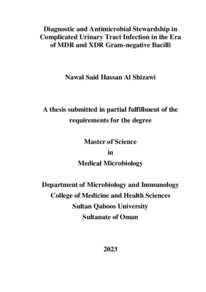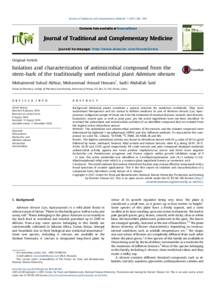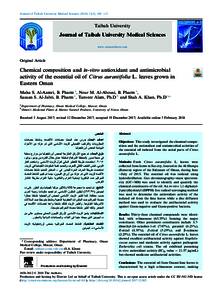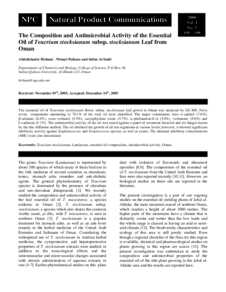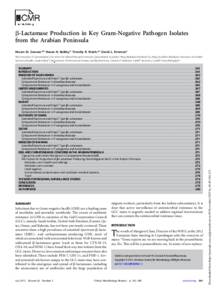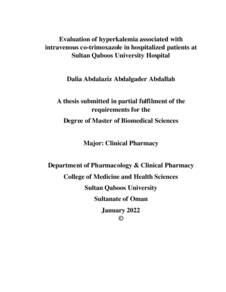Document
Diagnostic and antimicrobial stewardship in complicated urinary tract infection in the Era of MDR and XDR Gram-negative Bacilli.
Other titles
الاشراف على التشخيص ومضادات الميكروبات في حاالت عدوى المسالك البولية المعقدة في عصر العصيات سالبة الجرام متعددة المقاومة وشديدة المقاومة للمضادات الحيوية
Country
Oman
City
Muscat
Publisher
Sultan Qaboos University
Gregorian
2023
Thesis Type
Master's thesis
English abstract
Background: Treating complicated urinary tract infections (cUTIs) has become more
challenging due to escalating antimicrobial-resistance. Analysing the local etiology
and antimicrobial susceptibility profile of pathogens causing cUTI is important for
promoting evidence based antimicrobial prescribing. Adopting antimicrobial and
diagnostic stewardship in clinical and laboratory practice is essential for implementing
good practices. Microbiologists can further support optimum treatment protocols by
evaluating new or repurposed antimicrobials and assess their effectiveness for
providing appropriate recommendations.
Aim and Objectives: To analyse the local etiology and antimicrobial susceptibility
profile of pathogens causing cUTI and assess the prevalence of ESBL, AmpC and CRE
among E. coli and K. pneumoniae while also evaluating different phenotypic tests for
the detection of ESBL, AmpC and carbapenemase production in representative
isolates. We investigated the antimicrobial activity of revived and novel antibiotics
against representative E. coli and K. pneumoniae isolates. In-vitro synergy between
aztreonam and ceftazidime-avibactam against NDM-producing bacteria was assessed.
Antimicrobial resistance of representative strains producing AmpC β-lactamases and
carbapenemases was assessed by whole genome sequencing (WGS). Current
knowledge, awareness and practice (KAP) of pre-analytic diagnostic stewardship,
infection prevention control, and antibiotic use were assessed among patients and
nurses.
Methods: The clinical, etiological and antimicrobial susceptibility profile of patients
presenting with cUTI in Sultan Qaboos University Hospital (SQUH) between
September 2022 and August 2023 were analysed and the distribution of ESBLs, AmpC
β-lactamases, and CRE among E. coli and K. pneumoniae was identified
phenotypically. A total of 114 non-duplicate E. coli and K. pneumoniae isolates
demonstrating ESBL, AmpC and CRE phenotypes were isolated from urine samples
of patients with cUTI. The isolates were tested against revived and novel antibiotics
by disk diffusion test and E-test diffusion methods. For ESBL detection, potentiation
between several cephalosporins and aztreonam with four B-lactam/B-lactamase
inhibitor combinations were tested to assess which would be the best combination for
phenotypic detection of ESBL. For AmpC detection, the disk approximation assay and
the commercial D69C AmpC detection set were used. For carbapenemase detection,
the mCIM test and KPC/IMP/NDM/VIM/OXA-48 Combo test kit (Medomics, China)
were evaluated. The antimicrobial synergy between aztreonam (ATM) and
ceftazidime-avibactam (CZA) was assessed in 6 isolates by disk approximation and Etest cross method. WGS was carried out in representative isolates and the
bioinformatic analysis was performed using online tools for identifying multilocus
sequence typing, acquired resistance genes and plasmids. Assessment of KAP about
pre-analytic diagnostic stewardship, infection prevention control, and antibiotic use
among patients and nurses was performed using online questionnaires.
Results: The predominant bacterial uropathogens were E. coli (33%), K. pneumoniae
(13%) and Enterococcus species (12%). Among routinely tested antibiotics
ceftazidime-avibactam, meropenem, imipenem, ertapenem, amikacin, gentamicin and
piperacillin-tazobactam achieved >70% susceptibility rate among E. coli and K.
pneumoniae. E. coli exhibited a high susceptibility rate to nitrofurantoin (96%). The
overall prevalence of ESBL among E. coli and K. pneumoniae was 37.2%, while the
estimated prevalence of AmpC was 5.4% and the prevalence of CRE was 6.2%. E. coli
was the predominant ESBL and AmpC producer, whereas K. pneumoniae was the
major CRE producer. Among revived antibiotics, nitroxoline was the most active drug and all ESBL, AmpC and CRE-producing E. coli and K. pneumoniae were 100%
susceptible to nitroxoline, while mecillinam, fosfomycin and cefoperazone-sulbactam
exhibited excellent activity against ESBL and AmpC producers with susceptibility rate
of >80%. E. coli exhibited higher susceptibility to oral fosfomycin than K.
pneumoniae. Among novel antibiotics, cefiderocol showed the highest antibacterial
activities and >90% of CRE strains exhibited susceptibility to cefiderocol. The
susceptibility rate of imipenem-relebactam and plazomicin in ESBL and AmpCproducing strains was 100%. The antimicrobial activity of eravacycline was higher in
E. coli than in K. pneumoniae. For ESBL detection, amoxicillin-clavulanate and
ticarcillin-clavulanate were better inducers for aztreonam and 3rd/4th generation
cephalosporins than piperacillin-tazobactam and cefoperazone-sulbactam. Cefepime
was the best substrate for the detection of ESBL in AmpC co-producers. Using WGS
as a reference method, the D69C set and KPC/IMP/NDM/VIM/OXA-48 Combo test
kit achieved 100% sensitivity and specificity. ATM and CZA showed synergistic
activity in the majority of NDM-producing isolates (5/6). WGS revealed DHA-1 as
the predominant plasmid-mediated AmpC gene, while OXA-232 and NDM-5 as the
most common carbapenemase genes. All E. coli DHA-1 positive isolates co-harboured
the quinolone resistance gene qnrB4 and the sulfonamide resistance gene sul1 while
no aminoglycoside resistance genes were detected. The majority of CRE K.
pneumoniae carried other β-lactamase genes such as blaCTX-M-15, blaSHV, blaTEM, and
all co-harboured the OqxAB efflux pump genes and 77% carried the aminoglycoside
resistance gene armA. The analysis of KAP surveys revealed the need for improving
pre-analytic diagnostic stewardship among patients and nurses.
Conclusions: Nitroxoline, mecillinam and fosfomycin are promising oral
antimicrobial choices that can spare the use of cephalosporins and fluoroquinolones
for treating cystitis caused by ESBL and AmpC-producing Enterobacterales.
Cefiderocol monotherapy and a combination of ATM and CZA appeared to be good
colistin-sparing drugs for treating UTI caused by XDR/PDR Enterobacterales if no
other antibiotics were effective. For phenotypic detection of ESBL, we recommend
the use of DDST which combines clavulanic acid with 3rd generation cephalosporins
and cefepime for enhancing the possibility of ESBL detection, the D69C set for routine
detection AmpC β-lactamases and the KPC/IMP/NDM/VIM/OXA-48 Combo test kit
for detecting the type of carbapenemases. WGS results revealed DHA-1 was the
predominant AmpC while OXA-232 and NDM-5 were the circulating
carbapenemases. Effective interventions to improve the pre-analytic diagnostic
stewardship are essentially needed for better management of UTI.
Arabic abstract
نظرة عامة: أصبح علاج التهابات المسالك البولية المعقدة )cUTIs )أكثر صعوبة بسبب تصاعد المقاومة الميكروبية لمضادات الميكروبات. يعد تحليل خصائص الميكروبات المسببة لإلتهاب المسالك البولية المعقدة على الصعيد المحلي ومعرفة قابليتها للتأثر بمضادات الميكروبات أمًرا مهًما لتعزيز وصف مضادات الميكروبات القائمة على الادلة. يعد اعتماد الاشراف على مضادات الميكروبات والتشخيص في الممارسة السريرية والمختبرية أمًرا ضروريًا لتنفيذ الممارسات الجيدة. ويمكن ألخصائي علم الاحياء المجهرية دعم بروتوكوالت العلاج الامثل بشكل أكبر من خالل تقييم مضادات الميكروبات الجديدة أو المعاد استخدامها وتقييم فعاليتها لتقديم التوصيات المناسبة. الهدف: تحليل خصائص الميكروبات المسببة لإلتهاب المسالك البولية المعقدة ومعرفة قابليتها للتأثر بمضادات الميكروبات وتقييم مدى انتشار ESBL وAmpC وCRE بين الاشريكية القولونية والكلبسيال الرئوية مع تقييم اختبارات النمط الظاهري المختلفة للكشف عن إنتاج ESBL وAmpC وcarbapenemase في العزالت التمثيلية. قمنا بالتحقق من فعالية المضادات الحيوية التي تم إحياؤها والجديدة ضد عينات تمثيلية من الاشريكية القولونية والكلبسيال الرئوية. كما قمنا ب تقييم التآزر المخبري بين الازتريونام والسيفتازيديم-أفيباكتام ضد البكتيريا المنتجة للـ NDM. كما قامت هذه الدراسة أيضا بتقييم المقاومة لمضادات الميكروبات للبكتيريا المنتجة لـ lactamases-β AmpC و carbapenemases من خالل تسلسل الجينوم الكامل. كما قمنا ب تقييم المعرفة والوعي والممارسة لإلشراف التشخيصي قبل التحليل، ومكافحة الوقاية من العدوى، واستخدام المضادات الحيوية بين المرضى والممرضين. الطريقة: تم تحليل الملف السريري للمرضى الذين يعانون من التهاب المسالك البولية المعقدة في مستشفى جامعة السلطان قابوس بين سبتمبر - ٢ ٢ ٠ ٢ وأغسطس- ٣ ٢ ٠ ٢ والتحقق من الميكروبات المسببة لهذا الإلتهاب وتقييم تأثرها بمضادات الميكروبا ت ودراسة توزيع ESBLs وlactamases-β AmpC وCRE بين الاشريكية القولونية والكلبسيال الرئوية الذي تم تحديده ظاهريا. تم إستخالص ٤ ١ ١ عينة غير مكررة من الاشريكية القولونية والكلبسيال الرئوية توضح الانماط الظاهرية ESBL وAmpC وCRE من عينات بول المرضى الذين يعانون من التهاب المسالك البولية المعقدة ثم تم اختبار الحساسية للمضادات الحيوية المعاد إحياؤها والجديدة لهذه العينات باستخدام طرق النمط الظاهري diffusion disk وdiffusion test-E. للكشف عن ESBL، تم اختبار التقوية بين العديد من السيفالوسبورينات والازتريونام مع أربع مجموعات من مثبطات lactamase-B/lactam-B لتقييم أي منها سيكون أفضل مزيج للكشف المظهري عن ESBL. للكشف عن AmpC، تم استخدام اختبار تقريب القرص وطريقة الكشف ا لتجارية )C69D). للكشف عن carbapenemase، تم تقييم اختبار mCIM ومجموعة اختبار كومبو -48OXA/VIM/NDM/IMP/KPC( Medomics، الصين(. تم تقييم التآزر بين مضادات الميكروبات الازتريونام )ATM )والسيفتازيديم-أفيباكتام )CZA )في ٦ عزالت بكتيرية باستخدام طريقة تقريب القرص وطريقة اختبار تقاطع الشرائط. تم تنفيذ تسلسل الجينوم الكامل في العزالت التمثيلية وتم إجراء تحليل المعلومات الحيوية باستخدام أدوات عبر الانترنت لتحديد كتابة التسلسل متعدد البؤر وجينات المقاومة المكتسبة والبالزميدات. تم إجراء تقييم حول المعرفة والوعي والممارسة لإلشراف التشخيصي قبل التحليل، ومكافحة الوقاية من العدوى، واستخدام المضادات الحيوية بين المرضى والممرضين باستخدام الاستبيانات عبر الانترنت. النتائج: كانت الباكتيريا السائدة في عينات بول المرضى هي الاشريكية القولونيه )٪33(، الكلبسيال الرئوية )٪13(، والمكورات المعوية )٪12(. من بين المضادات الحيوية التي تم اختبارها بشكل روتيني، حقق سيفتازيديم- أفيباكتام، وميروبينيم، وإيميبينيم، وإرتابينيم، وأميكاسين، وجنتاميسين، وبيبيراسيللين- تازوباكتام معدل حساسية أكبر من %70 في الاشريكية القولونية والكلبسيال الرئوية. أظهرت الاشريكية القولونية معدل حساسية مرتفع للنيتروفورانتوين )٪96(. كان معدل الانتشار الاجمالي لـ ESBL في الاشريكية القولونية والكلبسيال الرئوية ،٪37.2 في حين كان معدل الانتشار المقدر لـ AmpC ٪5.4 وكان معدل انتشار CRE .٪6.2 كانت الاشريكية القولونية هي المنتج السائد لـ ESBL وAmpC، في حين كانت الكلبسيال الرئوية هي المنتج الرئيسي لـ CRE. ًطا وكانت جميع الاشريكية من بين المضادات الحيوية التي تم إحياؤها، كان النيتروكسولين هو الدواء الاكثر نشا القولونية والكلبسيال الرئوية المنتجة لـ ESBL وAmpC وCRE معرضة بنسبة ٪100 للنيتروكسولين، في حين سولباكتام نشا ESBL وAmpC مع ًط أظهر الميسيلينام والفوسفوميسين والسيفوبيرازون- ا ممتا ًزا ضد منتجي معدل حساسية < .٪80 أظهرت الاشريكية القولونية حساسية أعلى للفوسفوميسين المتناول عن طريق الفم مقارنة vii بلكلبسيال الرئوية. من بين المضادات الحيوية الجديدة، أظهر السيفيديروكول أعلى الانشطة المضادة للبكتيريا، وأكثر من ٪90 من سالالت CRE أظهرت حساسية للسيفيديروكول. كان معدل الحساسية لإليميبينيم-ريلباكتام والبالزوميسين في السالالت المنتجة للـ ESBL وAmpC .٪100 كان النشاط المضاد للميكروبات لإليرافاسيكلين أعلى في الاشريكية القولونية منه في الكلبسيال الرئوية. للكشف عن ESBL، كان الاموكسيسيلين- كالفوالنات وتيكارسيلين-كالفوالنيت محفزات أفضل لألزتريونام والسيفالوسبورينات من الجيل الثالث/الرابع من البيبراسيلين-تازوباكتام وسيفوبيرازون-سولباكتام. كما كان سيفيبيم هو أفضل مضاد للكشف عن ESBL في البكتيريا المنتجة لـ ESBL وAmpC معا. باستخدام تسلسل الجينوم الكامل كطريقة مرجعية، حققت مجموعة .٪100 بنسبة ونوعية حساسية KPC/IMP/NDM/VIM/OXA-48 Combo اختبار ومجموعة D69C نشا NDM( 6/5). كشف تسلسل الجينوم الكامل ًط أظهر ATM وCZA ا تآزريًا في غالبية العزلات المنتجة لـ عن -1DHA باعتباره جين AmpC السائد بوساطة البالزميد، في حين أن -232OXA و-5NDM هما جينات الكاربابينماز الاكثر شيو ًعا. جميع عزالت الاشريكية القولونيه الايجابية لـ -1DHA كانت تؤوي جين مقاومة الكينولون 4qnrB وجين مقاومة السلفوناميد 1sul بينما لم يتم اكتشاف أي جينات مقاومة لألمينوغليكوزيد. تحمل غالبية الكلبسيال الرئوية الايجابية لـ CRE جينات lactamase-B أخرى مثل -15M-blaCTX، وblaSHV، وblaTEM، وجميعها تشترك في إيواء جينات مضخة التدفق OqxAB ,بينما ٪77 تحمل جين مقاومة الامينوغليكوزيد ArmA. كشف تحليل الاستبيانات لتقييم المعرفة والوعي والممارسة لإلشراف التشخيصي قبل التحليل، ومكافحة الوقاية من العدوى، واستخدام المضادات الحيوية بين المرضى والممرضين عن الحاجة إلى تحسين الاشراف التشخيصي قبل التحليل بين المرضى والممرضين. الخالصة: يعد النيتروكسولين والميسيلينام والفوسفوميسين من الخيارات الواعدة لمضادات الميكروبات المتناولة عن طريق الفم والتي يمكن أن تستخدم كعلاج بديل عن السيفالوسبورينات والفلوروكينولونات لعلاج التهاب المثانة الناجم عن البكتيريا المعوية المنتجة للـ ESBL وAmpC. يبدو أن العلاج الاحادي بـ cefiderocol ومزيج من ATM وCZA من الادوية الجيدة التي تستخدم كعلاج بديل عن الكوليستين لعلاج التهاب المسالك البولية الناجم عن البكتيريا المعوية PDR/XDR إذا لم تكن المضادات الحيوية الاخرى فعالة. للكشف المظهري عن ESBL، نوصي باستخدام DDST الذي يجمع حمض clavulanic مع الجيل الثالث من السيفالوسبورينات والسيفيبيم لتعزيز إمكانية اكتشاف ESBL، ومجموعة C69D للكشف الروتيني عن lactamases-β AmpC ومجموعة نتائج كشفت .carbapenemases نوع عن للكشف KPC/IMP/NDM/VIM/OXA-48 Combo اختبار تسلسل الجينوم الكامل أن -1DHA هو AmpC السائد بينما كان -232OXA و -5NDM هما ا لـ carbapenemases المنتشرة. هناك حاجة أساسية للتدخالت الفعالة لتحسين الاشراف التشخيصي قبل التحليل من أجل إدارة أفضل لإلتهاب المسالك البولية.
Category
Theses and Dissertations

